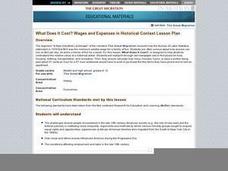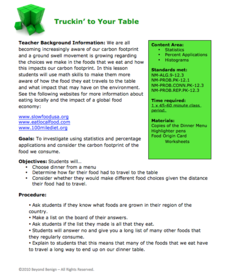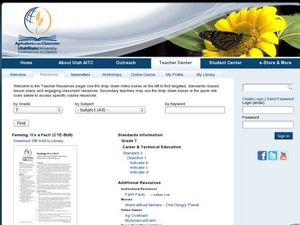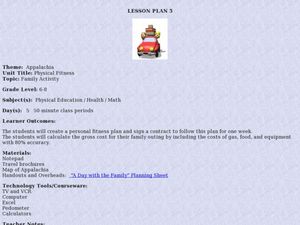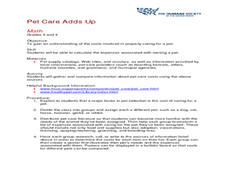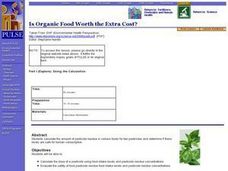Curated OER
Cutting Costs With Coupons.
Students clip coupons for food items, create a menu using those items, and add up the total savings. They correctly calculate the total amount of money that would be saved if they used the coupons.
Curated OER
Calculating Your Foodometer
Students explore environmental issues by completing a food production class activity. In this carbon footprint lesson, students discuss the types of foods they eat, where they come from and what types of methods are used to transport...
Curated OER
What Did It Cost 100 Years Ago?
Students compare prices of good across the century in order to introduce the topic of inflation. They undertand the concepts of inflation and Consumer Price Index (CPI), use online calculators to figure the approximate cost of goods...
Curated OER
Free Enterprise -- Product Cost
Students are introduced to the concept of free enterprise. In groups, they discuss the price of various food items and decide on which item to produce. They calculate the cost of producing the item and share their results with the class.
Curated OER
What Does It Cost? Wages and Expenses in Historical Context
Students research the relative value of a historical dollar. They use old newspapers to find costs for food, housing, clothing, and transportation and then calculate the number of hours a worker would need to be employed to live...
EduGAINs
Making Savvy Consumer Choices
It's never too early to learn about grocery budgeting. Middle schoolers delve into the world of consumer math with a lesson plan that focuses on both healthy choices and real-world math applications. Groups work together to form a...
Curated OER
Springbreak Trip
Twelfth graders plan and calculate the cost of taking a specific Spring Break trip, with a certain budget and given set costs. they determine miles traveled, gas costs, hotel expenses, etc.
Curated OER
The Quicker the Better? Food Processing
Sixth graders evaluate the nutrition of various foods. In this healthy eating lesson plan, 6th graders discuss the processing of many common foods and what this means. Students identify and research unfamiliar ingredients in processed...
Curated OER
And You Thought Gasoline Was Expensive!
Young scholars carry out a cost analysis. In this comparative math activity, students compare the cost of equal measures of gasoline to mouthwash, house paint, fruit juice, white-out, and other liquids.
Beyond Benign
Truckin’ to Your Table
Food takes a trip to the table. Class members choose a meal from a menu and calculate the total cost of the meal including tax and tip. Using a food origin card, pupils determine how far each of the ingredients of a meal traveled to end...
Curated OER
Costs of Providing for animals
Students explore the necessary costs of animals shelters and taking care of one pet. In this providing for animals lesson, students calculate the costs of keeping a pet. Students understand the need for outside funding for animal shelters.
Curated OER
Budget Bonanza
Students demonstrate how to use a budget plan. In this consumer math lesson, students calculate the total cost of data and determine if they are within budget. Students use calculators to determine the total cost. There is a rubric...
Mathalicious
Domino Effect
Carryout the instructional activity to determine the cost of pizza toppings from a Domino's Pizza® website while creating a linear model. Learners look through real data—and even create their own pizza—to determine the cost of each...
Curated OER
Children's Literature: math calculations
Students read the book Sam I Am and complete math calculations on the prices of ingredients that Sam did not want to eat. For this math calculations lesson plan, students list the items Sam would not eat into a computer program and...
Curated OER
Math: Afffordability of Food
Students examine food costs in various countries. Using the currency of various countries, they calculate the cost of food and then transfer it into dollars. Students also discuss related topics such as the effects of technology on diet.
Curated OER
Farming: It's a Fact!
Students use worksheets, food items, and computer programs to learn about the path of food from the farm to their meals. In this agriculture lesson, students use a provided worksheet to learn facts about farming. They use a bag of...
Rochester Institue of Technology
Meal Picking
Scholars explore systems design and its relation to meal picking by using computer simulations to test systems designs. They learn about the Pick-to-Light System and calculate average picking times.
Curated OER
Appalachia: Physical Fitness
Students plan a family fitness outing. In this physical education lesson, students will research possible physical activities which might be completed by a family during a daily-long outing in the Appalachian area. Students will...
Curated OER
Shopping-Unit Pricing
Comparing unit prices of food products is a skill that learners will use for the rest of their lives. Here is a simple plan that provides practice calculating the unit price for various grocery store products. Use two jars with differing...
Curated OER
Calculating The Poverty Line
Students examine the poverty line. In this poverty line lesson, students discover what the poverty line is and how the U.S. government determines it. Students calculate alternative poverty lines and examine their implications.
Curated OER
Pet Care Adds Up
Students calculate the costs of properly caring for a pet. In this animal welfare lesson, students use pet supply catalogs and websites to gather information about the cost of caring for a pet. Students are divided into groups and are...
Curated OER
Party Time
Students explore the cost of a party. In this math lesson, students plan a party and determine the cost of hosting a party. Students use information from grocery stores to determine the unit cost of items for the party.
Curated OER
Kitchen Calculations
Students compare eggs to other foods as a cost-effective protein source. They use formulas to determine prices in a worksheet and in local newspaper ads.
Curated OER
Is Organic Food Worth the Extra Cost?
Students calculate the amount of pesticide residue in selected foods for two
pesticides and determine if these levels are safe. They read an article about a
research study looking for metabolites of these pesticides in children. Finally,...




